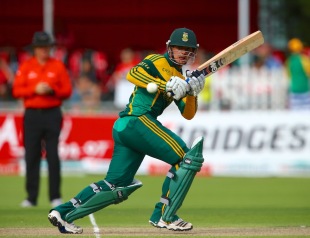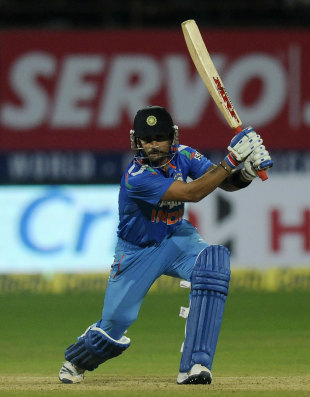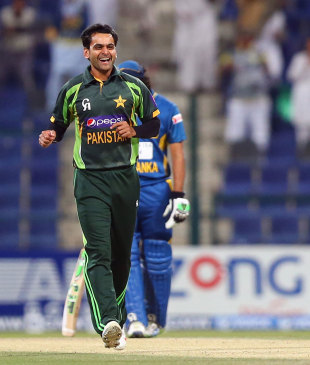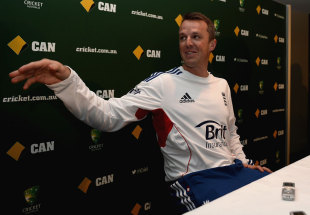Whitewashed in India, badly beaten in England and then lo and behold - a transformation and the return of the urn. Australia won't forget 2013 for a long time
Brydon Coverdale January 4, 2014

Steven Smith and Mitchell Johnson redeemed Australia in 2013 © Getty Images
For Australia, 2013 started with Mickey Arthur the coach, Shane Watson the vice-captain, Michael Clarke a selector, Michael Hussey a Test player, Matthew Wade the wicketkeeper, Ed Cowan an opener, Phillip Hughes the first drop, Ali de Winter the Test bowling coach, Stuart Law the batting mentor, and the Ashes in England's possession.
What a difference a year makes.
They begin 2014 with Darren Lehmann at the helm, Brad Haddin the wicketkeeper and vice-captain, Clarke no longer picking teams, Hussey retired, Chris Rogers a born-again Test player, Watson at No. 3, Craig McDermott back in charge of the bowlers and Michael di Venuto coaching the batsmen. And, most importantly, with the Ashes in their keeping.
There were on-field embarrassments and off-field humiliations. Their troughs seemed deeper than the Mariana Trench but they have finished the year on an Everest-like high. By the numbers, Australia played 14 Tests in 2013 for five wins, seven losses and two draws. But the numbers don't tell the full story. The severity of some defeats was scarcely believable, as was the propensity for things to go wrong behind the scenes.
In Hyderabad in March, Australia lost by an innings and 135, their tenth-heaviest loss in 136 years of Test history. At Lord's in July, they went down by 347 runs, their third-worst defeat in terms of runs alone. When Australia turned bad, they turned Walter White bad. And yet, at other times their losses were tight and stemmed only from losing key moments or sessions - notably at Trent Bridge and Chester-le-Street.
Australia were always going to struggle in India. Without an effective game plan against India's spinners and without faith in their own spinner, Nathan Lyon, who was dropped after the first Test, Australia could not handle the turning conditions. One of their few positives was that Steven Smith emerged as a classy Test batsman who could use his feet. That discovery would prove important later.
Off the field, the team management was unhappy with little things that weren't being done around the squad. That led to the "line-in-the-sand" moment, when four players, including vice-captain Watson, were suspended for one Test for not completing a task aimed at reflecting on how the team could improve. Arthur announced the decision and became irrevocably linked to it, though it was made by a committee of Arthur, Clarke and team manager Gavin Dovey.
It was an all-time low moment for Australia, not just for 2013. While there was something to be said for bringing the players into line and forcing them to think more about the team, it raised questions over why the little things had been allowed to slip so far that such a drastic measure had to be taken. Within four months Arthur had been sacked as coach and Lehmann was installed. Arthur had marked his line in the sand, Cricket Australia later set down theirs.
The Indian tour ended with a 4-0 thrashing, just as Australia had easily won 4-0 when they played at home against India the previous summer. It was an example of just how much work Australia must do to become competitive away from home. They were in foreign conditions in India but you'd have thought they were on another planet.
Their next engagement was the Champions Trophy in England, where Australia were defending champions but failed to win a match. More of a problem was what happened off field during the tournament, when David Warner took a swing at Joe Root in a Birmingham pub after England beat Australia. Warner was already on shaky ground after an abusive Twitter rant against two senior Australian cricket journalists earlier in the year and his punch at Root cost him his Test place.
It also cost Arthur his job. James Sutherland and Pat Howard quickly and decisively made the move less than three weeks before the first Ashes Test. Lehmann brought a sense of enjoyment to the group, though he was far from fun to be around after their loss at Lord's. Australia used 17 players during the five Tests in England, didn't settle on a batting order, dropped Ed Cowan and Phillip Hughes, failed to grab their chances and lost 3-0.
Ultimately, though, that campaign was a research mission, which was what Arthur and Clarke had always intended. The plan was to assess England's weaknesses, work towards a settled Australian outfit and push to regain the urn at home. As the Honda ad says, isn't it nice when things just work? And things not only worked at home for Australia, one thing especially fell fortuitously into place.
Mitchell Johnson played at the Gabba only because the likes of James Pattinson and Mitchell Starc were injured. His pace alarmed England and he was Man of the Match in Brisbane, Adelaide and Melbourne. It is pointless to play the "what-if" game, but impossible to imagine Australia 4-0 entering the Sydney Test were it not for Johnson.
The only sweep Australian fans thought they would see this summer was Warner's reverse, but a 5-0 result against England is now possible. Who'd have thought that after the Indian tour? Who'd have thought it when Arthur was sacked? When England won 3-0? Or when Australia started their home Ashes on day one at the Gabba by slipping to 6 for 132? But, as the old cricket cliché says, you don't judge a pitch until both teams have batted. Turns out you shouldn't judge a team until they have played at home and away, either.
In England, the pitches were dry and suited Graeme Swann's spin; in Australia, Swann's impact was deadened and their batsmen struggled to handle Australia's relentless pace. But, with a couple of exceptions, winning at home has not been Australia's big problem in recent years. Their challenge for 2014 is to show that they can transfer their form to foreign conditions, first against the world's No.1 team, South Africa, and then in the UAE against Pakistan.
They will likely take on those challenges with a team that could not have been predicted at the start of the year. Haddin and Rogers were both recalled in their mid-30s to add experience to a team that had lost Hussey and Ricky Ponting to retirement, and both made contributions to the Ashes triumph. Haddin's feat of rescuing Australia from first-innings holes in all five Tests was nothing short of extraordinary, but it also highlights a batting weakness that South Africa may exploit.
Remarkably, Australia used the same 11 players in all five Ashes Tests in Australia, the first time they had ever used an unchanged side throughout a five-Test series. There is a strong camaraderie among the group that did not appear evident in India and Lehmann's relaxed influence has played a role in that. The big questions are how this team will respond when they start struggling again and how long they can stay together. They end 2013 with the Ashes, but begin 2014 with further challenges ahead.
High point
The final day at the WACA was a celebration for the Australians, in every way. As England's last few wickets fell, the players signalled for the crowd to get involved, to cheer them home. The Ashes were to be regained seven years after Australia had last won them. Johnson and Ryan Harris were on the verge of tears as they shook hands with the England batsmen; Rogers and George Bailey were counting their blessings to be there, as was Warner, in a different way; Watson, Siddle, Smith and Haddin were forgetting all their failed Ashes campaigns of the past; Clarke was pleased to be an Ashes-winning captain. Lyon led the team in a rare public rendition of Underneath the Southern Cross on the WACA pitch a few hours later, and while a big night of celebrating followed, so did another victory in Melbourne a week and a bit later. The job was not yet done.
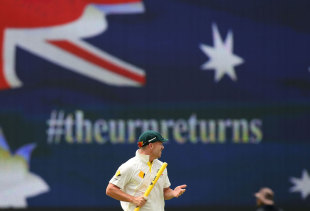
No one would have predicted that the urn would change hands by the end of the year © Getty Images
Low point
For Australia, the Indian tour was, in the words of Flo Rida, "low, low, low, low, low, low, low…" The worst came at the end of the second Test in Hyderabad and in the days that followed. The defeat by an innings and 135 runs was followed by the so-called homework task set by Arthur, which was followed by four players being stood down for a Test, which was followed by Watson flying home for the birth of his child and saying he would consider his cricketing future, which was followed by Pat Howard describing Watson as a team player "sometimes", which was followed by Watson returning to captain the team in Delhi due to Clarke's injury, which was followed by Clarke flying home while his team-mates lost inside three days. All in all, a rotten few weeks.
New kid on the block
Steven Smith made his debut three years ago but it wasn't until 2013 that he really established himself in the Test side. When he was picked for the tour of India he seemed the least likely member of the squad to play, but the homework suspensions gave him a chance and his 92 in Mohali was one of the bright points for Australia on an awful tour. He followed that with 89 in Manchester, an unbeaten 138 at The Oval and most importantly 111 in the first innings in Perth. That innings was the making of Smith as a Test batsman, scored as it was under pressure and with England a chance to fight back into the series. Smith's technique and temperament have improved, he uses his feet against spin and possess a sound cricketing brain. Expect him to remain at No. 5 for some time.
What 2014 holds
Australia play three Tests in South Africa in February-March and it is there that their attacking style will truly be tested. The top-order failures that occurred during the Ashes were papered over by Haddin's rescues; Dale Steyn, Vernon Philander and Co are unlikely to allow that to happen. A rare winter away from Test cricket follows, after the World Twenty20 in Bangladesh, before a Test series away against Pakistan and the home summer against India. Success away from home is the truest test of a team's ability, and that is how Australia will be judged in 2014.

